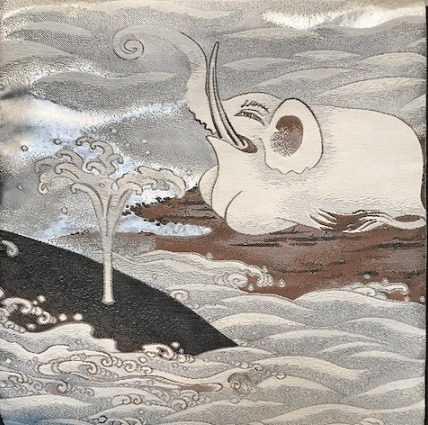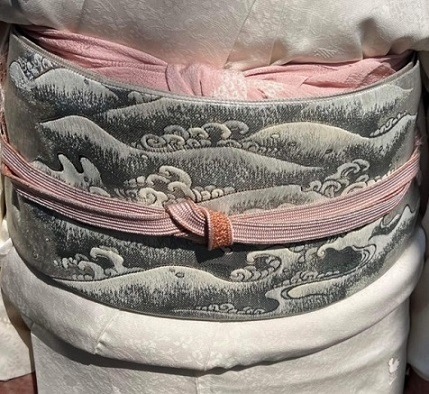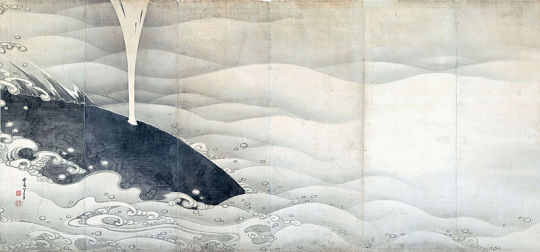#ito jakuchu
Text

50K notes
·
View notes
Text

Nandina and Rooster, by Itō Jakuchū, ca. 1761-1765
206 notes
·
View notes
Text

Baika kougetuzu painted by Ito Jakuchu (1716 - 1800)
#art#art history#artwork#painting#history#museums#culture#vintage#curators#classicalcanvas#ito jakuchu
181 notes
·
View notes
Text

Ito Jakuchu
(1716-1800)
Scroll part, EDO period
347 notes
·
View notes
Text






Unusual pattern choice for this modern high end obi, inspired by the famous Zo to Kujira-zu byôbu (Elephant and Whale folding screens) painted by mid-Edo animal lover artist Ito Jakuchu.
Those folding screens were rediscovered in 2008. There is apparently no hidden allegory behind the whale/elephant pairing beside the fact that artist once saw an elephant and a whale and (rightly) went "well they're neat".
Those screens were ordered to be displayed during Gion matsuri, and whimsical patterns were often favored for this occasion.
#japan#fashion#kimono#obi#elephant#zo#white elephant#whale#kujira#Zo to Kujira-zu#byobu#folding screen#Ito Jakuchu#Gion matsuri#着物#帯
250 notes
·
View notes
Text


Vincent van Gogh, The Green Parrot, 1886
Jakuchu, Green Parrot on Vine, no. 2, from the series Six Genuine Pictures by Ito Jakuchu, 1897
#ito jakuchu#vincent van gogh#japanese prints#japanese art#japanese artist#post impressionist art#post impressionism#woodcut#woodblock print#asian art#dutch artist#dutch painter#parrots#bird art#bird painting#beautiful birds#wildlife#modern art#art history#aesthetictumblr#tumblraesthetic#tumblrpic#tumblrpictures#tumblr art#aesthetic#beauty
55 notes
·
View notes
Text

Itō Jakuchū, "Old Pine Tree and Peacock", 1761
#ito jakuchu#art#painting#ukiyo e#animal painting#japanese painting#japanese art#17th century#paintings#peacock#animals in art#bird#birds#bird painting#birds in art
107 notes
·
View notes
Photo

ITO Jakuchu(伊藤若冲 Japanese, 1716-1800)
秋塘群雀図 Autumn Millet and Sparrows via more
621 notes
·
View notes
Photo

White Plum Blossoms and Moon by Ito Jakuchu (Undated, hanging scroll, ink and colour on silk)
#art#artwork#kunst#kunstwerk#ito jakuchu#asian art#asiatische kunst#tree#baum#blossoms#blüten#plum blossoms#pflaumenblüten#nature#natur#moon#full moon#moonlight#mond#vollmond#mondlicht#silk#seide
28 notes
·
View notes
Text

Itō Jakuchū (1716 –1800)
31 notes
·
View notes
Text
Itō Jakuchū: Potential for Flight

Swallow and Camellia by Itō Jakuchū (c. 1900). Ink and color on paper; Meiji era woodblock print reproduction.
I am enraptured by Itō Jakuchū’s art. The stark contrast between the ink-black background and the bold use of color on the foreground is immediately striking, sure. But it’s more than that.
The hues on Swallow and Camellia are not jump-at-you bright, but they are made dazzling nonetheless by graceful saturation. The crimson on the camelia is both soft and intense. Earthy tones on the leaves capture a natural elegance that reminds me of furyu (known in Chinese as fengliu) — a sense of sophisticated beauty present in nature. The concept of furyu originated in the Heian period and often translated to dazzling gardens inspired by a mindful appreciation for nature.
Some of that furyu-esque botanical elegance can be appreciated in Jakuchu’s paintings, with their intricate use of detail and pattern. Jakuchu often employed pointillism in his artworks, and though the context of his art is different from the Western perspective, they do have an impressionistic quality to them, even though Impressionism emerged in the late 1800s!
In any case, Japan’s hermitism during the Edo Period would have echoed the principles of furyu, which has been defined by art historians as “the recluse’s sense of aesthetics” (see an academic paper by Qiu, 2000, that explains the topic of furyu thoroughly).
Elegance certainly seems to be the main descriptor for Jakuchu’s work. But there is also a transcendent depth to his art. From a Westerner’s perspective, the use of a dramatic dark background is reminiscent of tenebrismo, and achieves a similar effect. Themes of transient beauty and the ephemeral quality of nature are brought to the foreground for consideration. Jakuchu, who’s artistic surname means “like the void”, was considered a lay Zen brother by the Buddhist community. As such, an appreciation for the uniqueness of the present moment contrasted against the existential experience of nothingness (not necessarily as dreadful as it sounds) would be a theme in line with Buddhist thinking.
Simply put, themes of life against death and activity against stillness seem to be at play in Jakuchu’s art. An interplay of color and starkness, darkness and motion situate the viewer in the scene captured by Jakuchu’s eye. Forms are outlined in such a way as to create a charged essence that pops into awareness. In this way, Jakuchu urges the viewer to appreciate the present moment with an artful, engaged eye.
Posted originally at INKBRUSHMOOD.com.
Read + Discuss!
8 notes
·
View notes
Photo

Plum Blossoms and Moon, by Itō Jakuchū, ca. 1760
Description
95 notes
·
View notes
Text

Title: Roosters
Artist: Ito Jakuchu
Date: 1716 - 1800
Style: Ukiyo-e
Genre: Animal Painting
#art history#art#painting#artwork#museums#history#culture#vintage#curators#ukiyo e#ito jakuchu#classicalcanvas
354 notes
·
View notes
Photo

Ito Jakuchu, Skull Painting, 1961
1K notes
·
View notes

